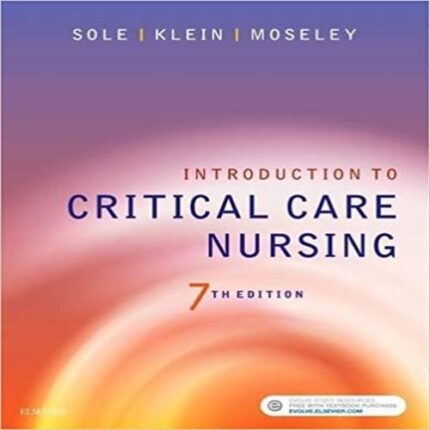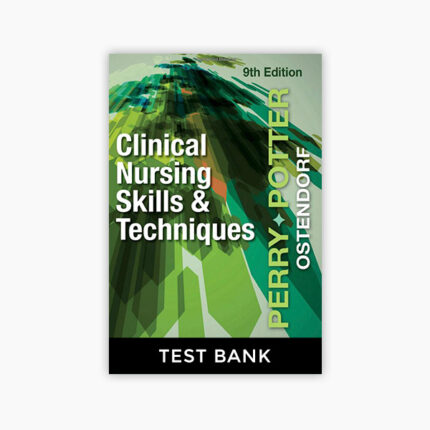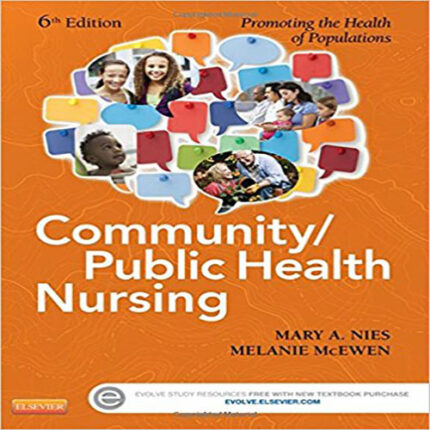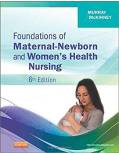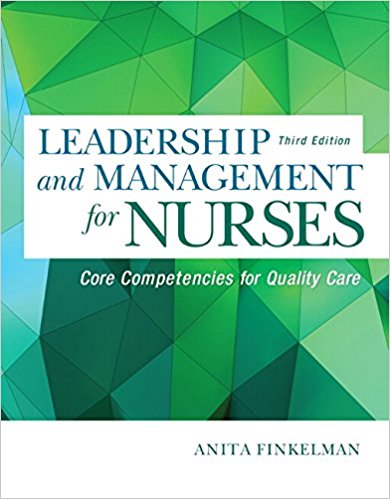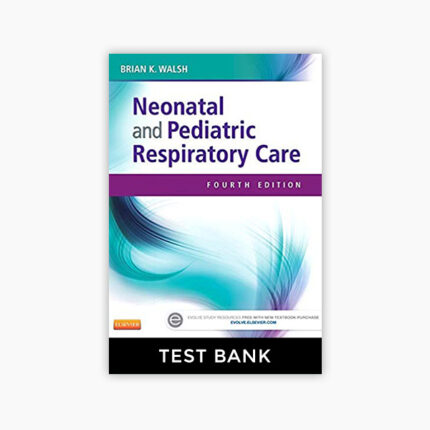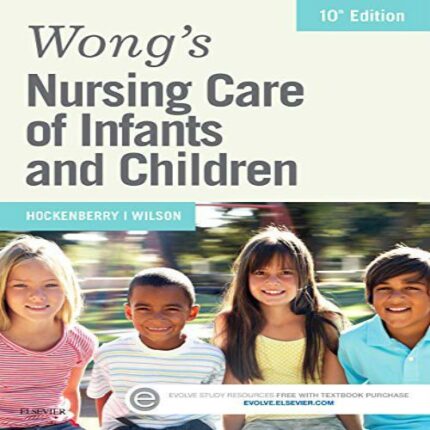Test Bank For Critical Care Nursing 8th Edition By Urden
Sample Questions
Chapter 04: Genetic Issues
Urden: Critical Care Nursing, 8th Edition
MULTIPLE CHOICE
- What is a genetic variant that exists in greater than 1% of the population termed?
| a. | Genetic mutation |
| b. | Genetic polymorphism |
| c. | Genetic deletion |
| d. | Tandem repeat |
ANS: B
When a genetic variant occurs frequently and is present in 1% or more of the population, it is described as a genetic polymorphism. The term genetic mutation refers to a change in the DNA genetic sequence that can be inherited that occurs in less than 1% of the population. Genetic material in the chromosome can also be deleted and new information from another chromosome can be inserted or can be a tandem repeat (multiple repeats of the same sequence).
PTS: 1 DIF: Cognitive Level: Remembering REF: p. 43
OBJ: Nursing Process Step: General TOP: Genetics in Critical Care
MSC: NCLEX: Health Promotion and Maintenance
- Which type of genetic disorder occurs when there is an interaction between genetic and environmental factors such as that which occurs with type 2 diabetes?
| a. | Chromosome |
| b. | Mitochondrial |
| c. | Multifactorial disorders |
| d. | Allele dysfunction |
ANS: C
In multifactorial disorders there is an interaction between vulnerable genes and the environment. Cardiovascular atherosclerotic diseases and type 2 diabetes are examples of multifactorial disorders that result from an interaction of genetic and environmental factors.
PTS: 1 DIF: Cognitive Level: Understanding REF: p. 46
OBJ: Nursing Process Step: General TOP: Genetics in Critical Care
MSC: NCLEX: Health Promotion and Maintenance
- Prader-Willi syndrome (PWS) is a rare genetic disorder in which genes on chromosome 15 (q11.2-13) are deleted. What type of disorder is PWS?
| a. | Chromosome disorder |
| b. | Mitochondrial disorder |
| c. | Complex gene disorder |
| d. | Multifactorial disorder |
ANS: A
Prader-Willi syndrome (PWS) is a chromosome disorder as a result of several missing genes on chromosome 15. In chromosome disorders, the entire chromosome or very large segments of the chromosome are damaged, missing, duplicated, or otherwise altered.
PTS: 1 DIF: Cognitive Level: Applying REF: p. 45
OBJ: Nursing Process Step: General TOP: Genetics in Critical Care
MSC: NCLEX: Health Promotion and Maintenance
- A family pedigree is used to determine whether a disease has a genetic component. What does a proband indicate in a family pedigree?
| a. | The disease being mother related or father related |
| b. | The first person in the family who was diagnosed with the disorder |
| c. | Who in the family is the xy band |
| d. | The disease genotype including locus |
ANS: B
For nurses, it is important to ask questions that elucidate which family members are affected versus those who are unaffected and then to identify the individuals who may carry the gene in question but who do not have symptoms (carriers). The proband is the name given to the first person diagnosed in the family pedigree. Homozygous versus heterozygous determines if the disorder is carried by a gene from one or both parents. The xy band determines if the disorder is carried through the sex genes. A disease locus is the genetic address of the disorder.
PTS: 1 DIF: Cognitive Level: Remembering REF: p. 46
OBJ: Nursing Process Step: General TOP: Genetics in Critical Care
MSC: NCLEX: Health Promotion and Maintenance
- Philadelphia translocation is a specific chromosomal abnormality that occurs from a reciprocal translocation between chromosomes 9 and 22, where parts of these two chromosomes switch places. This abnormality is associated with which disease?
| a. | Hemophilia A |
| b. | Chronic myelogenous leukemia |
| c. | Obesity |
| d. | Marfan syndrome |
ANS: B
Philadelphia chromosome or Philadelphia translocation is a specific chromosomal abnormality associated with chronic myelogenous leukemia. It occurs from a reciprocal translocation between chromosomes 9 and 22, where parts of these two chromosomes switch places. Hemophilia A is a sex-linked inheritance. Obesity is being studied with the FTO gene on chromosome 16. Marfan syndrome is classified as a single-gene disorder.
PTS: 1 DIF: Cognitive Level: Remembering REF: p. 42
OBJ: Nursing Process Step: General TOP: Genetics in Critical Care
MSC: NCLEX: Health Promotion and Maintenance
- What was the goal of the Human Genome Project?
| a. | Identifying haplotype tags |
| b. | Exposing untaggable SNPs and recombination hot spots |
| c. | Producing a catalog of human genome variation |
| d. | Mapping all the human genes |
ANS: D
The Human Genome Project was a huge international collaborative project that began in 1990 with the goal of making a map of all the human genes (the genome). The final genome sequence was published in 2003. The HapMap project was to identify haplotype tags. The Genome-Wide Association Studies was used to expose untaggable SNPs and recombination hot spots. The 1000 Genomes project was used to map all the human genes.
PTS: 1 DIF: Cognitive Level: Remembering REF: p. 49
OBJ: Nursing Process Step: General TOP: Genetics in Critical Care
MSC: NCLEX: Health Promotion and Maintenance
- The patient is placed under general anesthesia for a carotid endarterectomy. During the surgery, the patient develops muscle contracture with skeletal muscle rigidity, acidosis, and elevated temperature. What is a possible cause for malignant hyperthermia?
| a. | Polymorphism in RYR1 at chromosome 19q13.1 |
| b. | Variant in the VKOR1 gene |
| c. | Variant in the cytochrome P450 enzyme CYP2C9 gene |
| d. | Halothane overdose |
ANS: A
Individuals with polymorphisms in the ryanodine receptor gene (RYR1) at chromosome 19q13.1 are at risk of a rare pharmacogenetic condition known as malignant hyperthermia. In affected individuals, exposure to inhalation anesthetics and depolarizing muscle relaxants during general anesthesia induces life-threatening muscle contracture with skeletal muscle rigidity, acidosis, and elevated temperature. Warfarin is being researched as a variant in the VKOR1 gene and in the cytochrome P450 enzyme CYP2C9 gene.
PTS: 1 DIF: Cognitive Level: Evaluating REF: p. 53|Box 4-3
OBJ: Nursing Process Step: Diagnosis TOP: Genetics in Critical Care
MSC: NCLEX: Health Promotion and Maintenance
- What is the study of heredity particularly as it relates to the transfer heritable physical characteristics called?
| a. | Chromatids |
| b. | Karyotype |
| c. | Genetics |
| d. | Histones |
ANS: C
Genetics refers to the study of heredity, particularly as it relates to the ability of individual genes to transfer heritable physical characteristics. Each somatic chromosome, also called an autosome, is made of two strands, called chromatids, which are joined near the center. A karyotype is the arrangement of human chromosomes from largest to smallest. A specialized class of proteins called histones organizes the double-stranded DNA into what looks like a tightly coiled telephone cord.
PTS: 1 DIF: Cognitive Level: Remembering REF: p. 54
OBJ: Nursing Process Step: General TOP: Genetics in Critical Care
MSC: NCLEX: Health Promotion and Maintenance
- Each chromosome consists of an unbroken strand of DNA inside the nucleus of the cell. What is the arrangement of human chromosomes termed?
| a. | Chromatids |
| b. | Karyotype |
| c. | Genomics |
| d. | Histones |
ANS: B
A karyotype is the arrangement of human chromosomes from largest to smallest. Each somatic chromosome, also called an autosome, is made of two strands, called chromatids, which are joined near the center. Genomics refers to the study of all of the genetic material within cells and encompasses the environmental interaction and impact on biologic and physical characteristics. A specialized class of proteins called histones organizes the double-stranded DNA into what looks like a tightly coiled telephone cord.
PTS: 1 DIF: Cognitive Level: Remembering REF: p. 39
OBJ: Nursing Process Step: General TOP: Genetics in Critical Care
MSC: NCLEX: Health Promotion and Maintenance
- What is the study of all the genetic material within the cell and its impact on biologic and physical characteristics called?
| a. | Chromatids |
| b. | Karyotype |
| c. | Genomics |
| d. | Histones |
ANS: C
Genomics refers to the study of all of the genetic material within cells and encompasses the environmental interaction and impact on biologic and physical characteristics. Each somatic chromosome, also called an autosome, is made of two strands, called chromatids, which are joined near the center. A karyotype is the arrangement of human chromosomes from largest to smallest. A specialized class of proteins called histones organizes the double-stranded DNA into what looks like a tightly coiled telephone cord.
PTS: 1 DIF: Cognitive Level: Remembering REF: p. 39
OBJ: Nursing Process Step: General TOP: Genetics in Critical Care
MSC: NCLEX: Health Promotion and Maintenance
- A specialized class of proteins that organizes the double-stranded DNA into what looks like a tightly coiled telephone cord is known which of the following?
| a. | Chromatids |
| b. | Karyotype |
| c. | Genomics |
| d. | Histones |
ANS: D
A specialized class of proteins called histones organizes the double-stranded DNA into what looks like a tightly coiled telephone cord. Genomics refers to the study of all of the genetic material within cells and encompasses the environmental interaction and impact on biologic and physical characteristics. Each somatic chromosome, also called an autosome, is made of two strands, called chromatids, which are joined near the center. A karyotype is the arrangement of human chromosomes from largest to smallest.
PTS: 1 DIF: Cognitive Level: Remembering REF: p. 39
OBJ: Nursing Process Step: General TOP: Genetics in Critical Care
MSC: NCLEX: Health Promotion and Maintenance
- To achieve a consistent distance across the width of the DNA strand, the nucleotide base guanine (G) can only be paired with what other genetic material?
| a. | Adenine (A) |
| b. | Thymine (T) |
| c. | Cytosine (C) |
| d. | Sex chromosome X |
ANS: C
Four nucleotide bases—adenine (A), thymine (T), guanine (G), and cytosine (C)—comprise the “letters” in the genetic DNA “alphabet.” The bases in the double helix are paired T with A and G with C. The nucleotide bases are designed so that only G can pair with C and only T can pair with A to achieve a consistent distance across the width of the DNA strand. The TA and GC combinations are known as base pairs.
PTS: 1 DIF: Cognitive Level: Evaluating REF: p. 40
OBJ: Nursing Process Step: Diagnosis TOP: Genetics in Critical Care
MSC: NCLEX: Health Promotion and Maintenance
- Why are monozygotic twins separated at birth used to study the effects of genetics versus environment?
| a. | They share an identical genome. |
| b. | They have different sex chromosomes. |
| c. | They have mirror chromosomes. |
| d. | They have identical health issues. |
ANS: A
Studies of identical twins offer a unique opportunity to investigate the association of genetics, environment, and health. Identical twins are monozygotic and share an identical genome. Monozygotic twins are the same sex. Studies occur much less frequently today because tremendous efforts are made to keep siblings together when they are adopted. Genetics can be stable in a study group, but the environment and health issues are dynamic even in a controlled study group.
PTS: 1 DIF: Cognitive Level: Remembering REF: p. 48
OBJ: Nursing Process Step: General TOP: Genetics in Critical Care
MSC: NCLEX: Health Promotion and Maintenance
- The process that is used to make polypeptide chains that constitute proteins can be written as:
| a. | RNA ® DNA ® protein. |
| b. | DNA ® RNA ® protein. |
| c. | Protein ® RNA ® DNA. |
| d. | Protein ® DNA ® RNA. |
ANS: B
The nucleotides A, T, C, and G can be thought of as “letters” of a genetic alphabet that are combined into three-letter “words” that are transcribed (written) by the intermediary of ribonucleic acid (RNA). The RNA translates the three-letter words into the amino acids used to make the polypeptide chains that constitute proteins. This process may be written as DNA ® RNA ® protein.
PTS: 1 DIF: Cognitive Level: Remembering REF: p. 41
OBJ: Nursing Process Step: Diagnosis TOP: Genetics in Critical Care
MSC: NCLEX: Health Promotion and Maintenance
- What are the studies called that are done on large, extended families who have several family members affected with a rare disease?
| a. | Genetic association |
| b. | Genetic epidemiology |
| c. | Kinships |
| d. | Phenotypes |
ANS: C
In genetic epidemiologic research of a rare disease, it can be a challenge to find enough people to study. One method is to work with large, extended families, known as kinships, which have several family members affected with the disease. Genetic association studies are usually conducted in large, unrelated groups based on demonstration of a phenotype (disease trait or symptoms) and associated genotype. Genetic epidemiology represents the fusion of epidemiologic studies and genetic and genomic research methods. Phenotypes are different at different stages of a disease and are influenced by medications, environmental factors, and gene–gene interaction.
PTS: 1 DIF: Cognitive Level: Remembering REF: p. 48
OBJ: Nursing Process Step: Diagnosis TOP: Genetics in Critical Care
MSC: NCLEX: Health Promotion and Maintenance
- What is an example of direct-to-consumer genomic testing?
| a. | Genetic testing through amniocentesis |
| b. | Paternity testing from buccal swabs of the child and father |
| c. | Biopsy of a lump for cancer |
| d. | Drug testing using hair follicles |
ANS: B
An example of direct-to-consumer testing is paternity testing from buccal swabs of the child and father. Genetic testing can be done through biopsies and amniocentesis, but they are performed in a facility by a medical professional. Drug testing and genomic testing are two different tests and are unrelated.
PTS: 1 DIF: Cognitive Level: Evaluating REF: p. 53
OBJ: Nursing Process Step: Diagnosis TOP: Genetics in Critical Care
MSC: NCLEX: Health Promotion and Maintenance
- What was the Genetic Information Nondiscrimination Act (GINA) of 2008 designed to prevent from happening?
| a. | Abuse of genetic information in employment and health insurance decisions |
| b. | Genetic counselors from reporting results to the health insurance companies |
| c. | Mandatory genetics testing of all individuals with certain diseases |
| d. | Information sharing between biobanks that are studying the same genetic disorders |
ANS: A
The Genetic Information Nondiscrimination Act (GINA) of 2008 is an essential piece of legislation designed to prevent abuse of genetic information in employment and health insurance decisions in the United States. One of the paramount concerns in the genomic era is to protect the privacy of individuals’ unique genetic information. Many countries have established biobanks as repositories of genetic material, and many tissue samples are stored in medical center tissue banks. Some people who may be at risk for a disorder disease will not be tested because they fear that a positive result may affect their employability. GINA also mandates that genetic information about an individual and his or her family has the same protections as health information.
PTS: 1 DIF: Cognitive Level: Remembering REF: p. 53
OBJ: Nursing Process Step: Diagnosis TOP: Genetics in Critical Care
MSC: NCLEX: Health Promotion and Maintenance
MULTIPLE RESPONSE
- Which patients would be candidates for genetic testing for long QT syndrome (LQTS)? (Select all that apply.)
| a. | Patients with prolonged QT interval during a cardiac and genetic work-up |
| b. | Family history of positive genotype and negative phenotype |
| c. | Patients diagnosed with torsades de pointes |
| d. | Family history of sudden cardiac death |
| e. | Family history of bleeding disorders |
| f. | Family history of obesity |
ANS: A, B, C, D
Related Test Bank
Nursing Research Generating and Assessing Evidence For Nursing practice 9th edition – Test Bank


